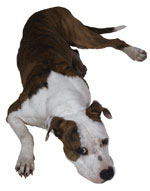Dog Training Articles
- Home Alone Blues
- The Missing Link To Behavior Modification
- Dog Training For The New Millennium
Home Alone Blues

Owning a dog that takes over your home when you're not around can be a problem, a frustrating one at that, because most owners feel that since they're not there they have no control over the dog's behavior when they are away. The truth is owners just may be contributing to this dilemma when their at home often adding to or causing the misbehavior. And so there is some control over the dog's behavior when your not home as we will soon find out.
First, you should do some basic obedience training in the area where your dog is usually left alone. This shows the dog to respect that area. Also you must first teach your dog to chew things that are appropriate and behave well when you're home before you skip to teaching it to behave well when you're absent. If you catch your dog chewing on an inappropriate object, make a loud noise with a shaker can to startle him and get him to stop the unwanted behavior. Then redirect him to a chew bone and praise him for chewing that. Avoid many toys made of different materials. It's hard for a dog to differentiate a leather chew toy from your leather couch. Most dogs or puppies engage in their wrong doings 15 to 20 minutes after their owners have left their home. Of course if you wait to pick up things all over the house 2 minutes before you leave while constantly telling your pet what a good doggy it's going to be, topped off with good-bye kisses and hugs, then your doggy should be filled with energy by the time you leave, which may cause your dog or puppy to let it's frustration out by chewing objects that it saw you picking up around the house which have your fresh scent on them. This is especially true when touching objects within your dog's reach without washing your hands during or after breakfast, for example
Once your dog is behaving well in your presence, then you may proceed to teach it that it's not all that bad when you leave home. Remember, if your going to pick up around the house, do it at least a half-hour before you leave. When you finally leave don't speak to your dog. Avoid even looking at him if possible. Return 5 minutes later and praise your dog for being good, if it was, and give it a treat. If your dog did something wrong, like chew on a forbidden object, then simply pick up the object and place it out of the dog's sight. Do not correct the dog. It is far too late for him to understand the cause and effect. You may correct it with a shaker can if you catch it in the act. Try this technique a couple times a day. Merely leaving the house and waiting outside your door may not be enough to convince your pooch that you are gone for the day. You should make a big act of leaving. Get in your car and let your dog hear your car engine turn on and drive off, only to be surprised 10 minutes later by your surprised visit followed by a treat or correction (if caught behaving wrong). Since you parked your car a block away before returning, your pet wasn't alarmed by the familiar sound of your car's engine in your driveway and gives you a better chance to catch Rover in his true home alone state. Being very quiet and keeping all your windows closed help this technique to be more effective especially when dogs with very good noses are involved. The more your dog behaves well between your departures and returns, you can prolong the time you are away from home by 10, 15, to 20 minutes gradually building up to the whole day. As your dog remembers not to forget that your surprise return could be in either 15 or 25 minutes or who knows when, Rover will start behaving in a way that's good for you and him instead of tearing up your home. It usually takes about 5 to 6 weeks to see results. The more your dog gets praise and love for behaving properly, the less your dog will behave in ways you dislike. These are just some solutions of many that can be applied to common behavior problems. But remember what works for one dog may not work for another. In any case the problem does not lie in the dog it self but the correct way to train the individual problem dog.
If you're not comfortable with the way your dog or puppy is responding to the training, then check with your veterinarian to rule out any physical conditions that may be causing or adding to the behavior problem. If your dog is in good health, then you should seek a professional dog trainer.
-Carlos Puentes is the Owner & Founder of K-9 Solutions a dog training service serving Dade & Broward Counties. K-9 Solutions specializes in behavior modification. He can be reached at (305) 825-0057 or (954) 443-3113
|
The Missing Link To Behavior Modification
|
I hear it all the time: I just can't get my dog to behave well for me. I've tried everything from yelling at him when he jumps up to rubbing his nose in his own stool and urine when he eliminates inside my home. I've even caught him in the act of tearing at my furniture and scolded him, still to no avail. "This is frustrating and I don't know what to do" is what you hear the person saying. Usually, if you have a frustrating situation like the aforementioned, not only do you not know what else to do, neither does your dog. The truth is that jumping, tearing things up (especially when teething) growling, biting, (in aggressive dogs) and urinating and defecating inside your home are all things that come naturally to dogs. Sometimes owners try to take away all of these things that a dog is inclined to do naturally. Because he has not been taught an alternative behavior, he becomes frustrated. You can bet he'll find a way to misbehave, anyway. That's all he knows to do. He doesn't automatically know that Come, Sit, Stay, and Heel are better for his owner and himself.

We as dog owners must teach him that. We go to the bathroom when we need to urinate. If there's not one handy then, we wait. If the dog feels the urge to urinate when inside your home, he'll do it right there and then if not housebroken. We hold our frustrations in, but a dog has no reason to, he's a dog. If he's a dominant, aggressive dog he will have no problem letting you know with a growl when you're doing something he doesn't like. If you leave it unattended, he could eventually bite you when he feels you are challenging him. Again, these are things that dogs do naturally. Of course, this behavior does not go well with us humans, but we can modify dogs' natural behavior so they can adapt well to human life; in turn, we can gain a better relationship with our best friends.
One way to avoid or solve behavior problems is through obedience training. When you start motivating your dog to continue a preferred behavior and stop a wrong behavior, the dog will do less of the bad behavior and more of the good, and the learning process would be under way. Positive reinforcement and negative reinforcement go hand in hand. You'll be teaching your dog "don't jump up on me, sit and stay." He can't jump up anymore if he's really taking you seriously and has learned the command. Also, consider a command like "don't bark aggressively at my children or a friend, instead go down and stay." You should decide what constitutes a threat, not the dog. It's strange to see a dog barking aggressively when lying on the floor, it goes against what the dog is feeling inside. When a dog is feeling aggressive his ears, tail and hackles go up. He wants to be on his toes and appear larger, but when you suddenly give the command to go down and stay, he has to relax and let you be the dominant leader-if you have taught him the lesson and he's taking you seriously. As you can see, obedience commands can help solve behavior problems.
Another type of training is automatic conditioning. This is basically catching your dog in the act of doing something good. Mostly, dogs are reprimanded when caught doing something wrong. Few are praised when doing something favorable and aren't motivated to continue the behavior. You don't have to give your dog a command to teach him good behavior. You can incorporate this type of training throughout your day; it only takes a second of your time. The moment your dog sits, praise him lavishly and give him a treat (if handy). There are many different behavior problems and many reasons why dogs behave poorly. Just because your dog is trained properly for basic obedience doesn't mean you'll be able to modify all behaviors. Your training may be too basic, and you both would benefit with more-advanced training. For example, your dog may respond perfectly on leash but run wild with another dog off leash. Then you would be one of the few owners who hasn't tried to stop all the wrong behaviors. Not too bad for the dog though, he'll have the best of both worlds.
-Carlos Puentes is the Owner & Founder of K-9 Solutions a dog training service serving Dade & Broward Counties. K-9 Solutions specializes in behavior modification. He can be reached at (305) 825-0057 or (954) 443-3113
|
Dog Training For The New Millennium
|
The month of December is a time filled with joy and happiness. Whether you're celebrating Christmas or Hanukkah, it is a time of giving, and one gift you may give or receive could be a puppy. If a puppy is on your list, then read on-the following may be of interest to you.
So the day has finally come and you are either giving away a cute and cuddly puppy or receiving one. There are more than 60 million dogs in the United States and only 10 percent have had some kind of obedience training. Over the years, owners have attempted to train their own pets only when bad habits have surfaced. Some have chosen to remove their dogs from the family, either by euthanasia (putting to sleep) or by taking the animal to a shelter. Mistreatment of dogs starts when owners don't attempt or know how to control them. For those of you giving away a puppy, some questions you might want to ask yourself are:

- What is the probability of the dog remaining in the household?
- Does the dog match the owner's lifestyle?
- What are the chances the dog is being given to a good home when the owner hasn't been successful in preventing and correcting previous behavior problems?
- What are the chances that the next good home may become even more chaotic for both dog and new owner?
- If the dog's behavior is not tolerable for the average person considering a pet, will the dog be neglected or put to sleep?
- Medical care, nutrition, exercise, and, of course, proper training, are all part of responsible pet ownership. Every day more and more pet owners understand the importance of training their dogs not only to fit in with human life, but to do it in a way that is mutually satisfying or rewarding. A canine that goes through behavior modification and is praised, petted, and given food rewards for obeying commands is playing out a subordinate but satisfying role in the household. That's good for both dog and owner. A well-behaved canine can be a positive experience for anyone. You can save the recipient of a puppy a number of headaches by purchasing a dog-training package to go along with the puppy. If dog training is not possible with your budget, then some type of training help in the form of a book, video, or a recommended dog-training instructor could make the difference between the puppy's survival and a one way ticket to the pound.
Keep in mind that not always is a training book or video the answer to all your puppy problems. The author cannot pop out of a book or video to correct a troubled handler or a handler who thinks he's training in accordance with the instructions. Although there are many good training books and videos on the market, they are not enough to solve the many specific problems that may occur which require special counseling by an experienced instructor. If you're on the receiving end and there's no dog training included with your puppy, then you have some last minute planning to do. At eight weeks of age, the brain waves of a puppy are the same length as those of an adult dog, so there is a lot of learning going on. Whether it's good or bad behavior depends on its environment, among many other factors. A puppy's attention span is very short; he is not completely developed physically and should be handled gently. Here are five easy steps for raising a puppy.
Never leave your puppy unsupervised. Always leave your pup in a crate or confined area where he cannot hurt himself. This will also prevent bad habits from developing.
Utilize critical stages. Weeks six to eight of your puppy's life are a time when a small amount of exposure to other dogs will have a lasting effect on how he relates to other canines throughout his life. Weeks eight to ten make up the critical stage for socialization to humans.
Establish yourself as pack leader. Your pup is a social pack animal. By establishing yourself as the "alpha dog" or leader of the pack, your pup will grow up to respect you, respond to you, bond to you and show the will to please you. He will also become a much more happy and confident dog.
Mix food with water before serving. Mix your pup's dry kibble with water so that it looks like a stew. Allow it to sit for 10 minutes before feeding. Kibble can expand up to 30 percent; let it expand in the bowl rather than in your pup's stomach, thus avoiding indigestion and possible behavior problems.
Touch conditioning. Touch all areas of your puppy's body so he will become conditioned to your touch and feel comfortable with you. It is just as important to train your pup as it is to bond with him. Get to know your puppy. See what motivates your new pet and what he was bred for; it could aid you in understanding his natural drives to get him to do what you want. In the beginning, there was the one-size-fits-all method, but those days are gone, and I'm sure you know that all pups are different and that there should be a customized training program designed according to your pup's temperament.
There are also innovative ideas that go along with the different training for today's lifestyles. For example, the idea to incorporate one type of training throughout your day, taking only a couple of seconds at a time, sounds very appealing to someone with a home office and a spouse, or for people always on the run. With the new millennium coming, everyone can and should train their pets. There have been great accomplishments during this millennium in the dog-training world, from the studies of Pavlov to the programs of the great present day trainers. My belief, along with many other dog trainers and behaviorists, is that we are just now scratching the surface of how we can bring people and dogs closer together, and that's good news for the new millennium! Once the month of December has come and gone, it doesn't mean that the joy and happiness of owning a puppy can't remain. If you give your puppy the training he deserves, you have nothing to lose and the beginning of a great lasting relationship to gain. The choice is yours.
-Carlos Puentes is the Owner & Founder of K-9 Solutions a dog training service serving Dade & Broward Counties. K-9 Solutions specializes in behavior modification. He can be reached at (305) 825-0057 or (954) 443-3113
|
|



